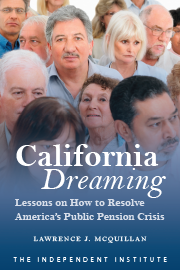California’s unchecked progressive state-government rule—exemplified by an insatiable desire to raise taxes, a radical environmentalist agenda, and a predilection for social engineering and for micromanaging seemingly every aspect of people’s lives—has raised the cost of living and diminished personal and economic freedoms so much that businesses, workers, and retirees have been fleeing the state for years. Now the state is projected to lose a seat in the House of Representatives for the first time in its history.
Among the strongest special interests—and the chief beneficiaries of this state of affairs—are the state’s labor unions, particularly its public-employee unions. From teachers to prison guards to police officers and firefighters to numerous other categories of state employees, unionized government workers exert a substantial influence on the Golden State’s policies and finances, to the detriment of its other residents and taxpayers. This union influence, combined with the monopolistic nature of government bureaucracies, has contributed to waste, fraud, abuse, and a lack of accountability, earning many state agencies and projects the dishonor of the California Golden Fleece Awards (conferred by the Independent Institute, where both authors of this article work) for such major issues as IT failures, housing, wildfires, and the state’s ill-fated high-speed-rail project.
One of the most obvious ways that public-employee unions affect the political landscape in California is through their efforts to swell the size of government (and their own ranks) through tax increases. More money in state coffers means more money to public employees and larger numbers of dues-paying union members. Union support has been important in a variety of major tax and fee increases, including Assembly Bill 32, the Global Warming Solutions Act of 2006. This measure established the state’s cap-and-trade system, which forces energy and industrial companies to purchase emissions credits, with the revenues used to fund the high-speed-rail boondoggle and various environmental programs. Union backing was also instrumental in the imposition of online sales taxes in 2011 (AB 155 and AB 28X1); substantial personal-income-tax increases through Proposition 30, which added multiple higher-income tax brackets in 2012; and significant hikes to the state’s gas taxes and vehicle fees via Senate Bill 1 in 2017. As a result, California has the highest gas tax in the nation (more than three times the national average), the highest state sales tax, and the three highest personal-income-tax brackets.
The incessant drive of the unions to increase government workers’ pay and benefits has led to a public-pension system that both sides of the political aisle recognize is unsustainable. Moreover, expansive state-court interpretations of government-worker benefit protections effectively mean that employees’ pensions are locked in and cannot be reduced without their permission—not even on a “going forward” basis for future work. This has come to be known as the “California rule.”
As detailed in the Independent Institute book California Dreaming: Lessons on How to Resolve America’s Public Pension Crisis, generous pension benefits, overly optimistic assumptions about the returns on pension-fund investments, and politically motivated underfunding have led to the state’s public-pension crisis, all facilitated by government-employee-union influence. California’s public-pension troubles began in earnest in 1999, when Senate Bill 400 raised government workers’ pension benefits by as much as 50 percent. The new benefit formula allowed a California Highway Patrol officer, for example, to retire after 30 years, as young as age 50, with a pension equal to 90 percent of his final salary. To make matters worse, the benefit enhancements were made retroactive, meaning that workers who had made contributions for years based on a lower expected benefit suddenly received a windfall.
SB 400 was enthusiastically supported by a wide swath of public-employee unions and sponsored by the heavily union-influenced California Public Employees’ Retirement System at the height of the dot-com boom. CalPERS argued that there would be little net cost to the state because of all the extra tax revenue it was raking in, as if the party was going to last forever.
The dot-com bubble inevitably burst, and stocks crashed the next year. But the damage had already been done, and taxpayers were now on the hook to make up pension-funding shortfalls for decades to come.
Perhaps the strongest special interest in Sacramento is the teachers’ unions, including the California Teachers Association and the California Federation of Teachers. Unfortunately for students, union rules and protections are not just expensive but have caused academic quality to deteriorate.
Things got so bad that a lawsuit was filed in 2014 on behalf of nine public-school students alleging that state laws granting teachers tenure after less than two years, establishing the “last in, first out” policy of laying off teachers based on seniority rather than effectiveness, and creating a lengthy, costly, and difficult process of getting rid of ineffective teachers so harmed students, particularly poor and minority children, that they violated the students’ constitutional rights. In Vergara v. California, Los Angeles County Superior Court judge Rolf Treu sided with the students, finding that “evidence has been elicited in this trial of the specific effect of grossly ineffective teachers on students. The evidence is compelling. Indeed, it shocks the conscience.” The victory was short-lived, however, as the decision was overturned by the Court of Appeals two years later and the California supreme court refused to hear a further appeal.
The issue of unions’ preventing public schools from getting rid of bad—and even abusive—teachers is not a new one. There have been many reports over the years of teachers’ being paid to do nothing but sit in empty “rubber rooms” while their disciplinary procedures play out, or being given tens of thousands of dollars to go away or not to fight terminations, because it is cheaper than trying to fire them.
More recently, the teachers’ unions have steadfastly refused to reopen schools that were closed because of the coronavirus outbreak, or have offered only limited and inadequate online instruction, even as teachers continue to collect full paychecks. Meanwhile, many private schools and other private businesses have managed to remain open and serve their students and customers.
Naturally, unions want to increase their ranks and influence, but sometimes they go about it in ways that use government coercion rather than simply offering workers an honest choice, and that harm both consumers and many of the workers on whose behalf they purport to act. The SEIU-UHW West health-care workers’ union has blatantly and repeatedly abused the state’s ballot-initiative process in an attempt to pressure the dialysis industry into unionizing its workers. The union has done this by advancing measures (Proposition 8 in 2018, Proposition 23 in 2020) that would have punished dialysis centers with pointless regulations and added labor costs, threatening the health and the very lives of thousands of fragile dialysis patients across the state. Fortunately, voters saw through both measures, which failed badly, by 20 and 27 points, respectively.
Even more notorious is California’s AB 5 legislation, ardently supported by the California Labor Federation and a host of other public- and private-sector unions, which essentially banned independent contracting work for millions of Californians (though more than 100 politically connected professions were later exempted from the sweeping law). While the stated purpose of the measure was to enhance worker protections, in reality it was a thinly veiled attempt to unionize hundreds of thousands of ride-share drivers. This nearly forced the shutdown of Uber and Lyft services statewide, but voters easily passed Proposition 22 last November to exempt ride-share and food-delivery drivers from the law.
Many other California entrepreneurs who prefer the flexibility of independent contract work but do not have the deep pockets or political connections to obtain exemptions have suffered substantial income losses from AB 5. It is clear that the unions do not care about these workers so long as they can add more union members—and their dues—to the rolls.
As the AB 5 example shows, California still has not learned the lesson that favoring narrow special interests while reducing employment opportunities, diminishing the quality of education, and continually increasing the cost of living is not a strategy for success. California illustrates the dangers of outsized public-employee-union influence and should serve as a warning to other states—and the federal government—that are following down the same path.











